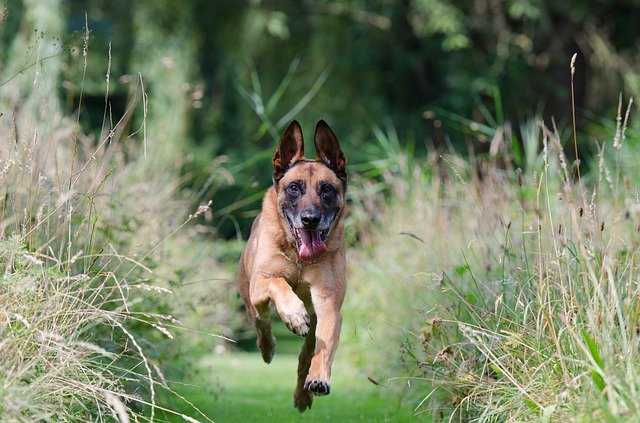Steps To Teach A Dog To Come

Teach your dog to come as early as possible in the training process. This is extremely important because it could prevent difficult situations both with other dogs and with people. If you are out in the park and another dog becomes aggressive then being able to call your dog to you immediately could ensure its safety. It is also a valuable command if your own dog becomes too excitable.
When you begin the training to teach your dog to come, you must make sure that you create an environment that is suitable for learning. A busy park with many people and dogs will not be a suitable learning environment because there will be too many distractions for your dog and he will be unable to concentrate properly. Instead, choose a quiet area, either inside your home or in your backyard, provided there are no distractions.

By now, your dog must have gotten used to the sit and stays commands. These two commands should be mastered before you teach your dog to come. The dog should be instructed to sit. You will then show him your hand which contains one of his favorite food treats. Close your hand, instruct your dog to stay, and then slowly back away three steps. Call your dog to you by saying his name and then the command "come."
It is vitally important to always use the same command and the same tone of voice when you teach your dog to come. This repetition will ensure that your dog learns the training completely. Once your dog comes to you he should be given the treat immediately and he should be praised enthusiastically. The dog should feel confident that by obeying the come command they will be rewarded.
This process should be repeated as many times as is necessary until the command is obeyed flawlessly. Again, repetition enforces the learning. The task can be made harder by gradually increasing the distance between you and your dog. When you think your dog is ready you can try the exercise outside, perhaps in a quiet area of the park, remembering always to have the treat to hand as a reward. As time goes on, the treats can be reduced and praise will be enough to reinforce the learning.
You'll also need a cache of little snacks to keep in your pocket. It's rare to find a dog who isn't driven by something tasty to eat.
How to Easily Teach Your Dog to Understand Commands
Step One: Heel
Begin walking with your left foot first, mentioning the dog's name while you give the "Heel" command, with the dog at knee level on your left side and the leash in your hand.
Give him food and positive reinforcement when he walks properly. If he doesn't get it right away, gently pull on the leash to get him back into place and start over.
Step Two: Sit
Simply place a treat behind his head while saying "Sit" and the dog's name. "If your dog does not respond, gently tap his buttocks while issuing the command. Then give them a treat and praise them."
Step Three: Stay
Begin by putting your dog in a sitting position. Make an open-palm order in front of him while stating "Stay" and his name. Maintain eye contact with him and hold him in the stay position for 30 seconds before saying "Okay!" Allow him to stay for longer lengths of time while you move further away.
Step Four: Come
Attach a six-foot non-retractable leash to your dog's "Sit" position. Pull gently while saying, "Come," and the dog's name in a friendly, enthusiastic voice.
When the dog comes up to you and sits, reward him with praise and a treat.

Steps to Teach a Dog to Come
#1. Get your dogs attention
Getting your dog's attention means making eye contact with him. One of the best ways of achieving this is through the clicker training method.
- Take your dog to a distraction-free environment, maybe a quiet room in your house. When your dog is NOT looking at you call his name. When he looks in your direction, make eye contact with him then click your clicker and give him a food treat.
- Build-in distractions gradually, for example, by repeating the exercise with other people in the room or try it out in the garden.
#2. Get to know what your dog likes
Make a mental note or better, a written note of all the things your dog enjoys as treats and rank them in importance: say from 1 to 3; 1 being a strong motivator, 2 having a lesser value than 1 as a motivator, and so on.
#3. Give your dog a good reason to come to you
So many of us fail with the recall exercise because we don't give our dogs a good enough reason to come back to us, especially when they are engrossed in doing something else. To combat this, try the following.
- Take your dog to a distraction-free place and attach him to a long training lead. Get down on the floor and call your dogs name. By now your dog should look at you immediately. When he does call him to you.
- Give your dog the incentive to come; clap your hands and get really animated. Your dog will then wonder what the fuss is all about and decide to check you out.
- If not give a little tug on his lead and call him towards you excitedly.
- When your dog comes to you take hold of his collar, praise him profusely and give him his treat.
- As soon as you have given your dog his treat, let him go again using a release command such as "OK". This lets your dog know he has done what is asked of him and he can now go back to play.
Author Bio
Contributor comprises full-time and freelance writers that form an integral part of the Editorial team of Hubslides working on different stages of content writing and publishing with overall goals of enriching the readers' knowledge through research and publishing of quality content.
Article Comments
No Comments!
At present there are zero comments on this article.
Why not be the first to make a comment?
Similar Articles
Sponsor
Search Articles
Experts Column
Latest Articles
Featured Articles
Most Popular Articles












